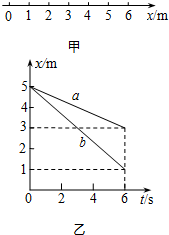问题
多选题
a、b两物体在t=0时刻沿同一直线开始运动,为了定量描述它们的运动情况,建立了一直线坐标系,如图甲所示.它们的位置坐标随时间的变化关系如图乙所示,则下列说法中正确的是( )
A.a、b两物体的出发点相同
B.t=2s时a的速度大于b的速度
C.a、b两物体的运动方向相同
D.0-6s内a通过的位移大于b通过的位移

答案
A、由图可知,两物体均从原点正方向5m处开始运动,故出发点相同,A正确;
B、两物体均做匀速直线运动,a的斜率小于b的斜率,所以a的速度一直小于b的速度,故B错误;
C、ab两物体均从5m处向原点运动,故运动方向相同,故C正确;
D、由图可知,6s内a的位移为3-5=-2m; b的位移为1-5=-4m;故b的位移大于a的位移,故D错误;
故选AC.
